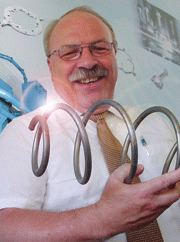E-Archive
MFN Trainer Column
in Vol. 10 - March Issue - Year 2009
Shot Peening and Mass Production

Albert Schlatter
Specialists are responsible for many shot-peening applications. As the term "specialist" suggests, these are people with specific professional knowledge and relevant experience. As a result, with highly complex shot-blasting applications in particular, it is practically impossible for basic errors to be made. A requirement for this is, however, that these well-qualified specialists are able to contribute significantly to the decision-making process.
In my experience, with other applications, particularly in mass production, either not enough specialists are involved or their influence on decisions affecting the process is insufficient. Therefore, errors are made that could have been easily avoided with suitable knowledge. I would like to use the following 3 examples from different fields of mass production to demonstrate how, even today, easily avoidable errors in various process stages are made.
Example 1:
Safety parts for the automobile industry are produced in a forge. After the forming process, the parts have to be descaled by blasting. It is expected with the descaling blasting, although not clearly defined, that a certain shot peening effect will be achieved. The parts are blasted in apron conveyor blast cleaning machines. It was decided to reduce the costs for the blasting process by reducing the blasting time.
Tests showed that the descaling process would be fastest and thus lowest cost using grit abrasive. This was also the reason why the use of grit abrasive instead of steel shot was seriously considered.
Only when external specialists were brought in, was it possible to convince the decision makers of the necessity of using a spherical blasting material suited to the application.
Example 2:
In a production line consisting of all the necessary machine tools for machining crankshafts, one of the last applications removed the burrs, caused during the processing, using very small, round, blasting media.
The blasting machine, and thus the deburring application using shot blasting, was a part of this production line for years, without causing any problems worth mentioning.
This changed after a new generation of tools was installed in the processing machines. With these tools, it was possible to process the crankshafts without producing flash.
For economical reasons, the now unnecessary deburring process and with it the blasting machine was eliminated. The consequence was a number of unexpected crankshaft breakages, the cause of which could not be explained in any way. Since the production line had been set up, changes had continuously been made to the machines, and even the crankshaft material had been improved.
Protracted, extensive and very expensive investigations finally found the cause of the crankshaft breakages.
Looking back, the simple and plausible explanation is that the deburring by shot blasting application had created a shot peening effect, which had contributed significantly to an increase in the life span of the crankshafts.
Example 3:
Over several years a project had been worked on and planned in a foundry for a new production line for special safety parts for automobiles. This included a high-performance blasting machine for de-sanding and cleaning the parts.
The most important requirement for the blasting machine was complete removal of sand so that the parts could be processed further afterwards without any problems. Another very important point was that the safety parts would not be damaged during the blasting process by impacts. During the project phase, blasting tests were carried out both in the laboratory and on external machines. The result was a special (hanger type) blasting machine with several blast wheels arranged in a special pattern including a new in-line operation without rotating the parts in the blast area. The complete production line was implemented and consisted of moulding machine, automatic loading of parts, pouring equipment, mould cooling system, blasting machine, automatic parts unloading, dust filter and forging press.
The result was very good both in terms of quality and quantity.
After approx. 2 years, internal discussions took place at the foundry on whether to use the blasting machine for shot peening application as well. The result was that without being able to rotate the parts in the blasting area, this application was not possible with this machine.
Many more examples could be given, but those already illustrated are sufficient to show that it is usually the small things that make a difference. It shows clearly, however, that where economic and technical interests meet, objective discussions on the basis of substantiated arguments have to be carried out in order to find the best solution.
We can learn from these examples that all applications, including shot peening, have to be included in the discussion starting as early as the planning phase. If there are no specialists available, they have to be found from external sources.
Courses and training sessions on shot peening processes are available nowadays making it relatively simple for a company confronted with this technology in the production process to build up an appropriate level of knowledge.
For questions contact albert@mfn.li
Trainer Column
by Albert Schlatter,
Official MFN Trainer
more information at www.mfn.li/trainers



























